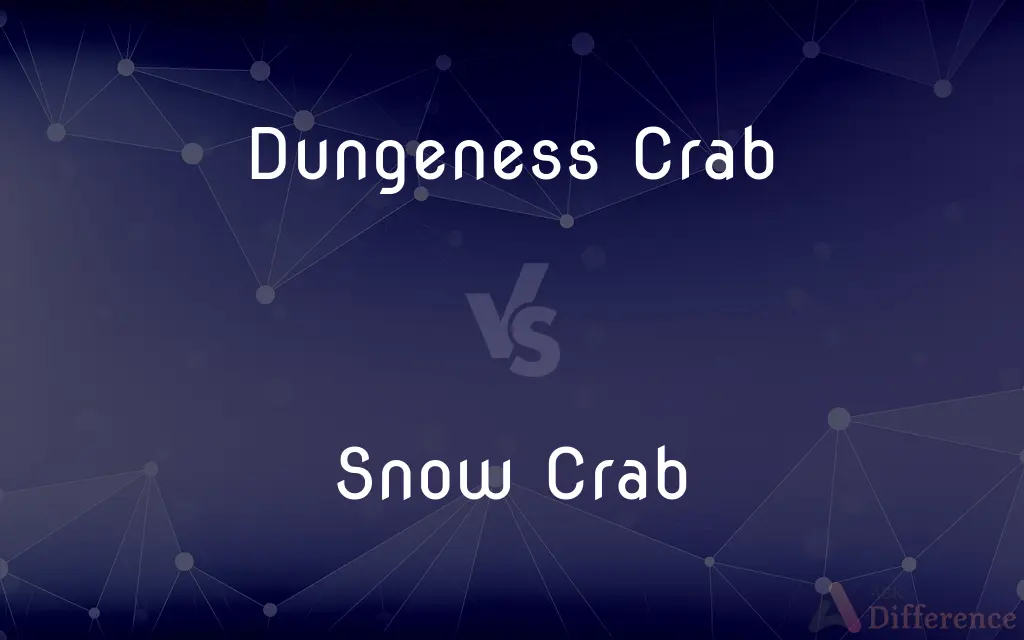Dungeness Crab vs. Snow Crab — What's the Difference?
Edited by Tayyaba Rehman — By Urooj Arif — Published on March 11, 2024
Dungeness Crab is known for its sweet, delicate flavor and tender meat, primarily found off the West Coast of the US, while Snow Crab, often caught in the North Atlantic and Arctic Ocean, offers slightly sweet, briny flavors with a firm texture.

Difference Between Dungeness Crab and Snow Crab
Table of Contents
ADVERTISEMENT
Key Differences
Dungeness Crab, harvested mainly from the Pacific Northwest, is celebrated for its rich, buttery taste. It's a preferred choice for gourmet dishes due to its larger size and the substantial amount of meat inside its shell. In contrast, Snow Crab, with its long, spindly legs and smaller clusters, is prized for its fine, sweet meat that's easier to extract from its thinner shell, making it a favorite in buffets and seafood platters.
Dungeness Crabs can weigh up to 4 pounds, offering a generous yield of meat, while Snow Crabs, though lighter, compensate with their elongated legs packed with accessible, flavorful meat. This difference in meat yield influences their culinary uses and market price, with Dungeness often being more expensive.
In terms of habitat, Dungeness Crabs thrive in the sandy bottoms and eelgrass beds of the West Coast's cooler waters, influencing their unique taste. Snow Crabs prefer the cold, deep waters of the Atlantic and Arctic, contributing to their distinct, slightly briny flavor.
Cooking methods for both crabs vary due to their shell strength and meat texture. Dungeness typically requires careful steaming or boiling to preserve its delicate flavor, while Snow Crab’s thinner shell makes it suitable for a range of cooking methods, including steaming, boiling, and grilling.
Both crabs are nutritional powerhouses, offering high-quality protein, omega-3 fatty acids, and essential vitamins and minerals. However, Dungeness Crab tends to have a slightly higher calorie and fat content, reflecting its richer taste and texture.
ADVERTISEMENT
Comparison Chart
Flavor
Sweet, delicate, and buttery
Slightly sweet and briny
Habitat
Pacific Northwest, sandy bottoms, and eelgrass beds
North Atlantic and Arctic Ocean, cold deep waters
Size and Weight
Up to 4 pounds, larger body
Lighter, with long, spindly legs
Meat Yield
Generous yield, meatier sections
Easier-to-extract meat from legs, smaller clusters
Cooking Methods
Best steamed or boiled to preserve flavor
Versatile: steamed, boiled, grilled
Compare with Definitions
Dungeness Crab
Preferred in gourmet cooking.
Dungeness Crab is often featured in upscale seafood dishes.
Snow Crab
Characterized by its long, thin legs.
Snow Crab is easily recognizable by its spindly legs filled with sweet meat.
Dungeness Crab
Requires careful cooking methods.
We steamed the Dungeness Crab to perfection, enhancing its natural flavors.
Snow Crab
Commonly used in a variety of dishes.
We used Snow Crab in both our appetizer and main course.
Dungeness Crab
A species of crab found in the western North America, known for its sweet flavor.
The chef prepared a Dungeness Crab feast for the main course.
Snow Crab
A type of crab found in the North Atlantic and Arctic Ocean, appreciated for its firm texture.
Snow Crab legs are a staple in seafood buffets.
Dungeness Crab
Renowned for its significant meat yield.
Dungeness Crab provides more meat per crab, making it a luxurious choice.
Snow Crab
Its meat is slightly briny.
The Snow Crab added a delightful briny flavor to the dish.
Dungeness Crab
Harvested from the Pacific Northwest.
The Dungeness Crab season is eagerly anticipated by seafood lovers.
Snow Crab
Suitable for multiple cooking methods.
Grilled Snow Crab legs were the highlight of our barbecue.
Common Curiosities
What is the main flavor difference between Dungeness and Snow Crab?
Dungeness Crab has a sweet, delicate, and buttery flavor, while Snow Crab is slightly sweet and briny.
How are these crabs typically cooked?
Dungeness is best steamed or boiled, while Snow Crab can be steamed, boiled, or grilled.
Where is Dungeness Crab found?
It is primarily found in the Pacific Northwest, in sandy bottoms and eelgrass beds.
What makes Snow Crab unique in texture?
Snow Crab has a firm texture, thanks to its long, thin legs that are packed with sweet meat.
Are these crabs available year-round?
Availability can vary by region and fishing regulations, but both are often available fresh or frozen year-round.
Which crab offers more meat yield?
Dungeness Crab typically offers a more generous meat yield, especially in its body.
Do Dungeness and Snow Crab have the same nutritional value?
Both are nutritious, offering high-quality protein and omega-3s, though Dungeness may have slightly more calories and fat.
Can you eat the whole Dungeness Crab?
While most of the crab is edible, it's common to consume primarily the meat from the body and legs.
Which crab is more expensive?
Generally, Dungeness Crab is more expensive due to its larger size and higher meat yield.
What is the best way to store these crabs?
Fresh crab should be cooked the day of purchase or stored in the coldest part of your refrigerator for up to 3 days.
What are some popular dishes made with Dungeness Crab?
Dungeness Crab is often served in crab cakes, salads, soups, and as a main course.
Is Snow Crab easy to eat?
Yes, Snow Crab's thinner shell and leg meat make it particularly easy to extract and eat.
How do you know when these crabs are fully cooked?
The shell turns bright red, and the meat is opaque and tender.
What are some common ways to prepare Snow Crab?
Snow Crab can be enjoyed steamed with butter, in seafood boils, or as part of sushi rolls.
Can you freeze Dungeness and Snow Crab?
Yes, both can be frozen, though it's best to cook them first to preserve texture and flavor.
Share Your Discovery

Previous Comparison
Sequence vs. Chronological Order
Next Comparison
Neurons vs. NeurogliaAuthor Spotlight
Written by
Urooj ArifUrooj is a skilled content writer at Ask Difference, known for her exceptional ability to simplify complex topics into engaging and informative content. With a passion for research and a flair for clear, concise writing, she consistently delivers articles that resonate with our diverse audience.
Edited by
Tayyaba RehmanTayyaba Rehman is a distinguished writer, currently serving as a primary contributor to askdifference.com. As a researcher in semantics and etymology, Tayyaba's passion for the complexity of languages and their distinctions has found a perfect home on the platform. Tayyaba delves into the intricacies of language, distinguishing between commonly confused words and phrases, thereby providing clarity for readers worldwide.
















































